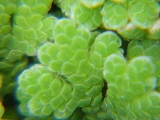
Azolla filiculoides
Encyclopedia
Azolla filiculoides is a species of Azolla, native to warm temperate and tropical regions of the Americas
as well as most of the old world including Asia and Australia.
It is a floating aquatic fern, with very fast growth, capable of spreading over lake surfaces to give complete coverage of the water in only a few months. Each individual plant is 1-2 cm across, green tinged pink, orange or red at the edges, branching freely, and breaking into smaller sections as it grows. It is not tolerant of cold temperatures, and in temperate regions it largely dies back in winter, surviving by means of submerged buds. Like other species of Azolla, it can fix nitrogen
from the air.
Fossil
records from as recent as the last interglacial
s are known from several locations in Europe
(Hyde et al. 1978).
, or by removal from lakes for use as green manure
. It has become naturalized
, sometimes also an invasive species
, in several regions, including western Europe
, southern Africa
, tropical Asia
, Australia
(where it is considered native), and New Zealand
.
Americas
The Americas, or America , are lands in the Western hemisphere, also known as the New World. In English, the plural form the Americas is often used to refer to the landmasses of North America and South America with their associated islands and regions, while the singular form America is primarily...
as well as most of the old world including Asia and Australia.
It is a floating aquatic fern, with very fast growth, capable of spreading over lake surfaces to give complete coverage of the water in only a few months. Each individual plant is 1-2 cm across, green tinged pink, orange or red at the edges, branching freely, and breaking into smaller sections as it grows. It is not tolerant of cold temperatures, and in temperate regions it largely dies back in winter, surviving by means of submerged buds. Like other species of Azolla, it can fix nitrogen
Nitrogen fixation
Nitrogen fixation is the natural process, either biological or abiotic, by which nitrogen in the atmosphere is converted into ammonia . This process is essential for life because fixed nitrogen is required to biosynthesize the basic building blocks of life, e.g., nucleotides for DNA and RNA and...
from the air.
Fossil
Fossil
Fossils are the preserved remains or traces of animals , plants, and other organisms from the remote past...
records from as recent as the last interglacial
Interglacial
An Interglacial period is a geological interval of warmer global average temperature lasting thousands of years that separates consecutive glacial periods within an ice age...
s are known from several locations in Europe
Europe
Europe is, by convention, one of the world's seven continents. Comprising the westernmost peninsula of Eurasia, Europe is generally 'divided' from Asia to its east by the watershed divides of the Ural and Caucasus Mountains, the Ural River, the Caspian and Black Seas, and the waterways connecting...
(Hyde et al. 1978).
Cultivation
The species has been introduced to many regions of the Old World, grown for its nitrogen-fixing ability which can be utilized to enhance the growth rate of crops grown in water like riceRice
Rice is the seed of the monocot plants Oryza sativa or Oryza glaberrima . As a cereal grain, it is the most important staple food for a large part of the world's human population, especially in East Asia, Southeast Asia, South Asia, the Middle East, and the West Indies...
, or by removal from lakes for use as green manure
Green manure
In agriculture, a green manure is a type of cover crop grown primarily to add nutrients and organic matter to the soil. Typically, a green manure crop is grown for a specific period of time , and then plowed under and incorporated into the soil while green or shortly after flowering...
. It has become naturalized
Naturalisation (biology)
In biology, naturalisation is any process by which a non-native organism spreads into the wild and its reproduction is sufficient to maintain its population. Such populations are said to be naturalised....
, sometimes also an invasive species
Invasive species
"Invasive species", or invasive exotics, is a nomenclature term and categorization phrase used for flora and fauna, and for specific restoration-preservation processes in native habitats, with several definitions....
, in several regions, including western Europe
Europe
Europe is, by convention, one of the world's seven continents. Comprising the westernmost peninsula of Eurasia, Europe is generally 'divided' from Asia to its east by the watershed divides of the Ural and Caucasus Mountains, the Ural River, the Caspian and Black Seas, and the waterways connecting...
, southern Africa
Africa
Africa is the world's second largest and second most populous continent, after Asia. At about 30.2 million km² including adjacent islands, it covers 6% of the Earth's total surface area and 20.4% of the total land area...
, tropical Asia
Asia
Asia is the world's largest and most populous continent, located primarily in the eastern and northern hemispheres. It covers 8.7% of the Earth's total surface area and with approximately 3.879 billion people, it hosts 60% of the world's current human population...
, Australia
Australia
Australia , officially the Commonwealth of Australia, is a country in the Southern Hemisphere comprising the mainland of the Australian continent, the island of Tasmania, and numerous smaller islands in the Indian and Pacific Oceans. It is the world's sixth-largest country by total area...
(where it is considered native), and New Zealand
New Zealand
New Zealand is an island country in the south-western Pacific Ocean comprising two main landmasses and numerous smaller islands. The country is situated some east of Australia across the Tasman Sea, and roughly south of the Pacific island nations of New Caledonia, Fiji, and Tonga...
.

